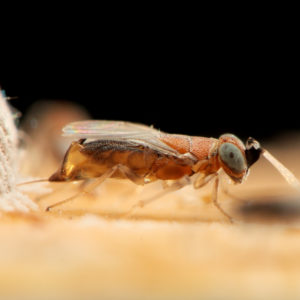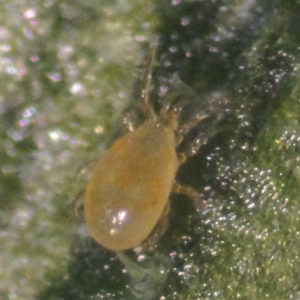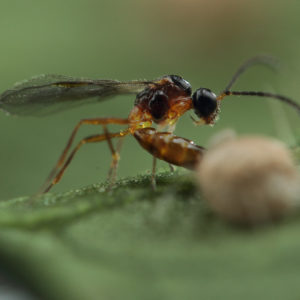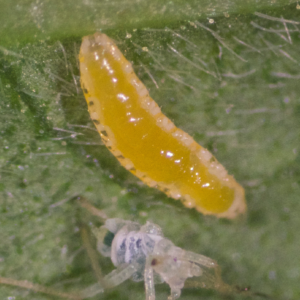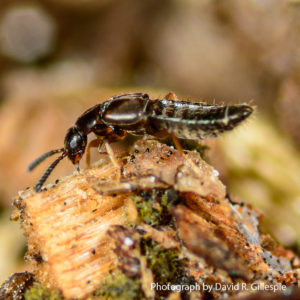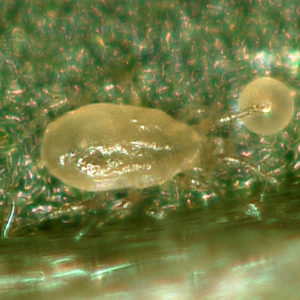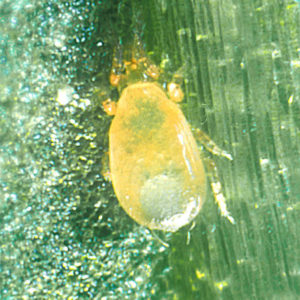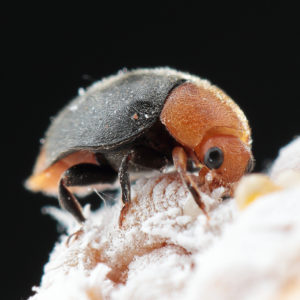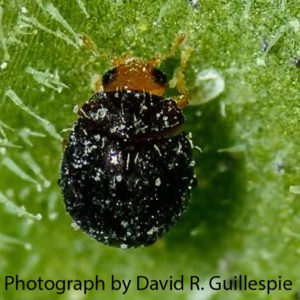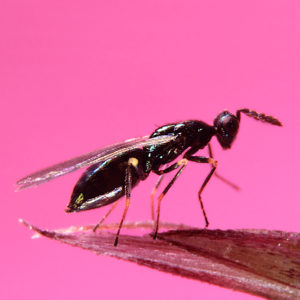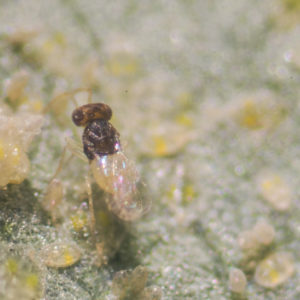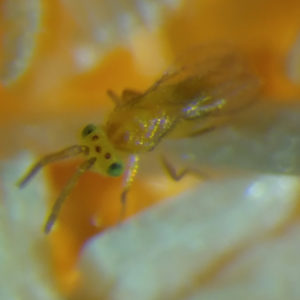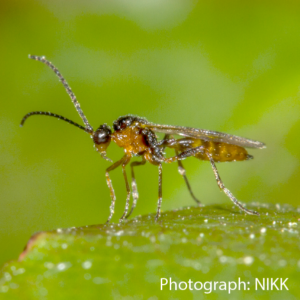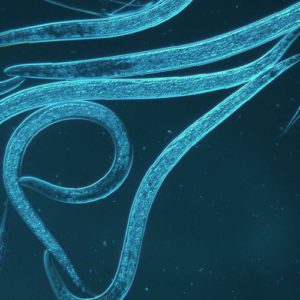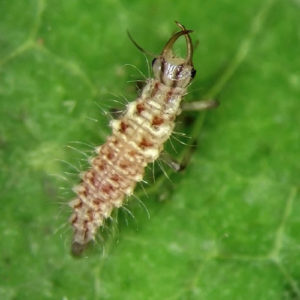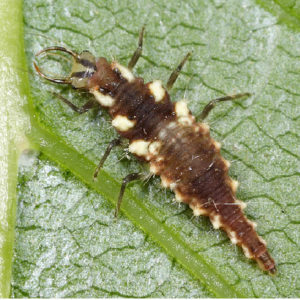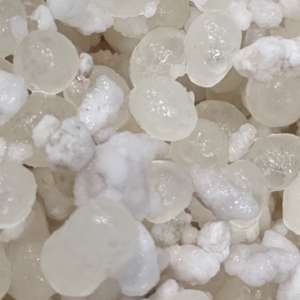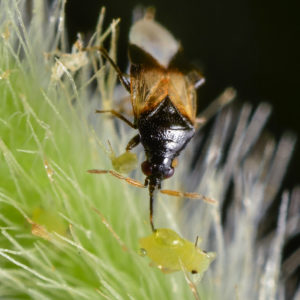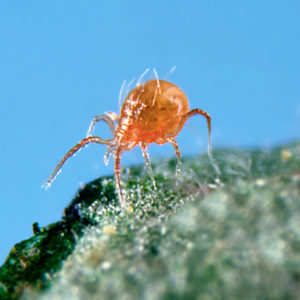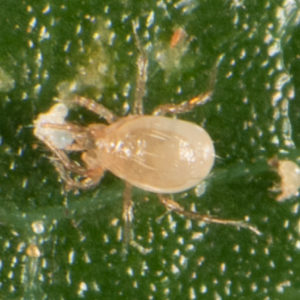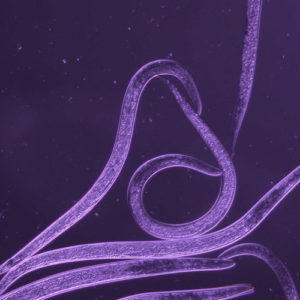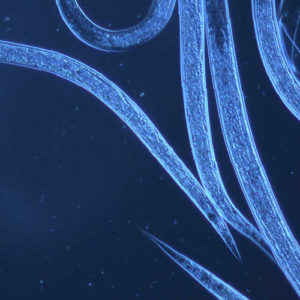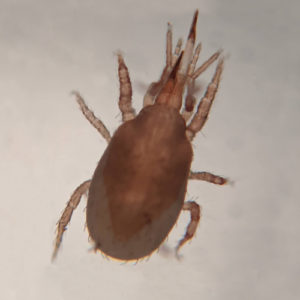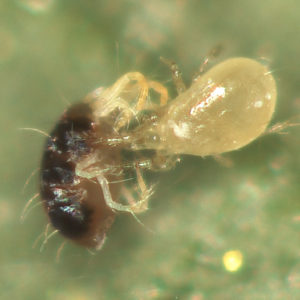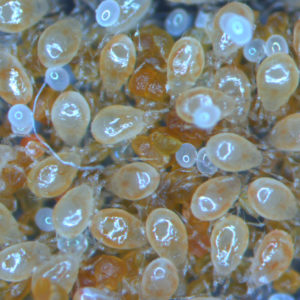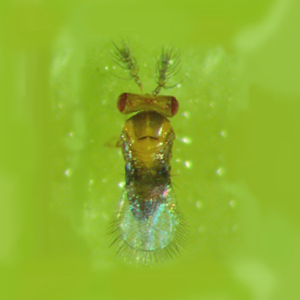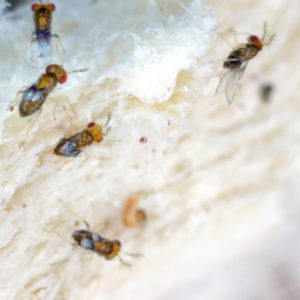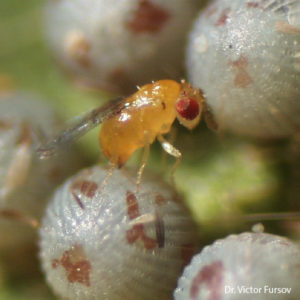BioAnagyrus (Anagyrus vladimiri) is a solitary endoparasitoid of mealybugs in greenhouses, open fields and fruit crops worldwide.
BioAndersoni
BioAndersoni (Amblyseius andersoni) is a predatory mite that feeds on small arthropod prey and pollen. BioAndersoni is less than 1mm in length and is often used in tomatoes due to its ability to maneuver between trichomes. They are active across a wide temperature range, allowing for early season introduction into crops yet might enter diapause with cooler temperatures and short day lengths (<10 hr.).
BioAphidius
BioAphidius (Aphidius colemani ) is a parasitic wasp. This polyphagous parasitoid attacks over 40 species of aphids.
BioAphidoletes
BioAphidoletes (Aphidoletes aphidimyza), commonly referred to as the gal midge, is a midge whose larvae feed on over 70 aphid species.
BioAphytis
BioAphidius (Aphidius colemani ) is a parasitic wasp. This polyphagous parasitoid attacks over 40 species of aphids.
BioAtheta
BioAtheta (Dalotia coriaria) is a fast-moving, soil dwelling rove beetle. A generalist predator, it feeds on a wide range of small insects and mites but is primarily an egg predator. BioAtheta is used in the control of fungus gnats, thrips pupae, shore flies, moth fly larvae, root mealybugs, springtails and other small arthropods.
BioCalifornicus
BioCalifornicus (Neoseiulus californicus) is an effective predatory mite of a wide array of pest mites.
BioCucumeris
BioCucumeris (Neoseiulus cucumeris) is a predatory mite widely used in the control of immature thrips (egg and larvae). It also feeds on several mite pests. Although very small (1mm), BioCucumeris can be recognized by its oblong shape and quick mobility along the underside of leaves and in flowers.
BioCryptolaemus
BioCryptolaemus (Cryptolaemus montrouzieri) is a predatory beetle, also known as the “Mealybug destroyer” because it is a voracious predator of multiple species of mealybugs in both greenhouses and open fields.
BioDelphastus
BioDelphastus (Delphastus catalinae) is a predatory beetle for the control of cotton whitefly (Bemisia tabaci) and greenhouse whitefly (Trialeurodes vaporariorum).
BioDiglyphus
BioDiglyphus (Diglyphus isaea) is an ectoparasitic wasp that parasitizes leaf miner larvae in field and greenhouse crops.
BioEncarsia
BioEncarsia (Encarsia formosa) is a parasitic wasp of the Aphelinidae family. E. formosa can utilize at least 15 species of whitefly as hosts but the principal host is the greenhouse whitefly. The tiny females are black with a yellow abdomen and opalescent wings while the males (although rare) are completely black in color. BioEncarsia should only be applied when temperatures range between 20-30°C.Parasitized greenhouse whitefly pupae turn black in about 10 days and are easily distinguished from non-parasitized hosts.
BioEretmocerus
BioEretmocerus (Eretmocerus eremicus) is a parasitic wasp used for the control of sweet potato whitefly and greenhouse whitefly. Adult females are very small (1mm) and light yellow in color while males are darker. E. eremicus parasitize and feed on whitefly larvae.
BioErvi
BioErvi is an effective parasitic wasp for larger aphid species that are not effectively controlled by Aphidius colemani such as potato aphids (Macrosiphum euphorbiae), foxglove aphids (Aulacorthum solani) as well as pea aphids (Acyrthosiphon pisum) and can also parasitize cannabis aphids (Phorodon cannabis) .
BioHb
BioHb is an Entomopathogenic nematode containing infective juveniles of Heterorhabditis bacteriophora in an inert carrier.
BioCarnea (lacewing)
BioCarnea (Chrysoperla carnea) is an insect of the Chrysopidae family. The delicate looking adult feeds on nectar and pollen while the larvae of BioCarnea is the active predator. The first three larvae instars, are the voracious ones.
BioLacewing (rufilabris)
BioLacewing (Chrysoperla rufilabris) also known as the red-lipped green lacewing, is an insect of the Chrysopidae family. The delicate looking adult feeds on nectar and pollen while the larvae of BioLacewing is the active predator. The three larval instars, are the voracious ones.
nemaplus®Depot
Once the capsules come into contact with soil or substrate, the alginate shell becomes permeable within a week and the beneficial nematodes emerge. Over a period of several weeks, new nematodes actively search for larvae. After locating pest larvae, nematodes invade through natural body openings and inject bacteria into the insect. Bacteria develop within the insect and it dies of septicemia after 2-3 days. Nematodes reproduce inside the dead larva. Thousands of new nematodes leave the dead larva and search for further prey.
BioOrius (insidiosus)
BioOrius (Orius insidiosus) also known as the insidiosus flower bug, is a predatory minute pirate bug equipped with piercing-sucking rostrum and two pairs of wings, the front pair being partially rigid.
BioPersimilis
BioPersimilis (Phytoseiulus persimilis) is a predatory mite, proven outstanding, aggressive and highly effective against spider mites. The adult female is a distinctive reddish-orange color with a pear-shaped body.
BioPersi+
BioPersi+ (Phytoseiulus persimilis) is a predatory mite, proven outstanding, aggressive and highly effective against spider mites. The adult female is a distinctive reddish-orange color with a pear-shaped body. Its long front legs allow it to move quickly and easily navigate spider mite webs.
BioSf
Nematodes actively search for larvae. After locating pest larvae, nematodes invade through natural body openings and inject bacteria into the insect. Bacteria develop within the insect and it dies of septicemia after 2-3 days. Nematodes reproduce inside the dead larva. Thousands of new nematodes leave the dead larva and search for further prey.
BioSc
Nematodes actively search for larvae. After locating pest larvae, nematodes invade through natural body openings and inject bacteria into the insect. Bacteria develop within the insect and it dies of septicemia after 2-3 days. Nematodes reproduce inside the dead larva. Thousands of new nematodes leave the dead larva and search for further prey.
BioStratio
BioStratio (Stratiolaelaps scimitus) is a soil-dwelling predatory mite whose nymphs and adults feed on fungus gnat larva, thrips pupae and other small invertebrates. These predatory mite stay at the base of plant stems and on the soil, rarely transferring onto the plant itself.
BioSwirski
BioSwirski (Amblyseius swirskii) is an efficient predatory mite used for the control of young stages of the western flower thrips as well as the eggs and young nymphs of white flies. It also feeds on red spider mites as well as on broad mites.
BioSwirski Combo
BioSwirski Combo contains the predatory mite Amblyseius swirskii and BioArtFeed, premium quality decapsulated Artemia cysts ( brine shrimp eggs). BioSwirski is a proven and highly effective predator, while BioArtFeed enables its early establishment.
BioTrichominutum
BioTrichominutum (Trichogramma minutum) is an egg parasitoid used in IPM programs to control various lepidopteran pests. The adult T. minutum measures around 0.3 mm and is pale yellow with red eyes.
The female lays its eggs in lepidopteran eggs and can parasitize up to ten eggs a day. The larva kills the developing embryo of the host and feeds on the egg contents. After the pupation stage it emerges as an adult, through a circular hole in the egg. The adult wasp is able to mate shortly after emerging.
BioTricho Mix
BioTricho Mix (Trichogramma brassicae, Trichogramma ostrinae, Trichogramma minutum) contains three different species of Trichogramma, egg parasitoids used in IPM programs to control various lepidopteran pests. This product is recommended for use when you are unsure of the species of caterpillars present in the crop. The females lay their eggs in lepidopteran eggs and can parasitize up to ten eggs a day. The larva kills the developing embryo of the host and feeds on the egg contents. After the pupation stage it emerges as an adult, through a circular hole in the egg. The adult wasp is able to mate shortly after emerging.
BioTrichoostriniae
BioTrichogramma (Trichogramma cryotophlebiae) is a parasitic wasp for the control of the False codling moth (Thaumatotibia leucotreta) and the Macadamia nut borer (Thaumototibia batrachopa).
BioTrichopretiosum
BioTrichopretiosum (Trichogramma pretiosum) is an egg parasitoid used in IPM programs to control various lepidopteran pests. The adult T. pretiosum measures around 0.3 mm and is pale yellow with red eyes.
The female lays its eggs in lepidopteran eggs and can parasitize up to ten eggs a day. The larva kills the developing embryo of the host and feeds on the egg contents. After the pupation stage it emerges as an adult, through a circular hole in the egg. The adult wasp is able to mate shortly after emerging.
BioTrichobrassicae
BioTrichobrassicae (Trichogramma brassicae) is an egg parasitoid used in IPM programs to control various lepidopteran pests. The adult T. brassicae measures around 0.3 mm and is pale yellow with red eyes.
The female lays its eggs in lepidopteran eggs and can parasitize up to ten eggs a day. The larva kills the developing embryo of the host and feeds on the egg contents. After the pupation stage it emerges as an adult, through a circular hole in the egg. The adult wasp is able to mate shortly after emerging.
